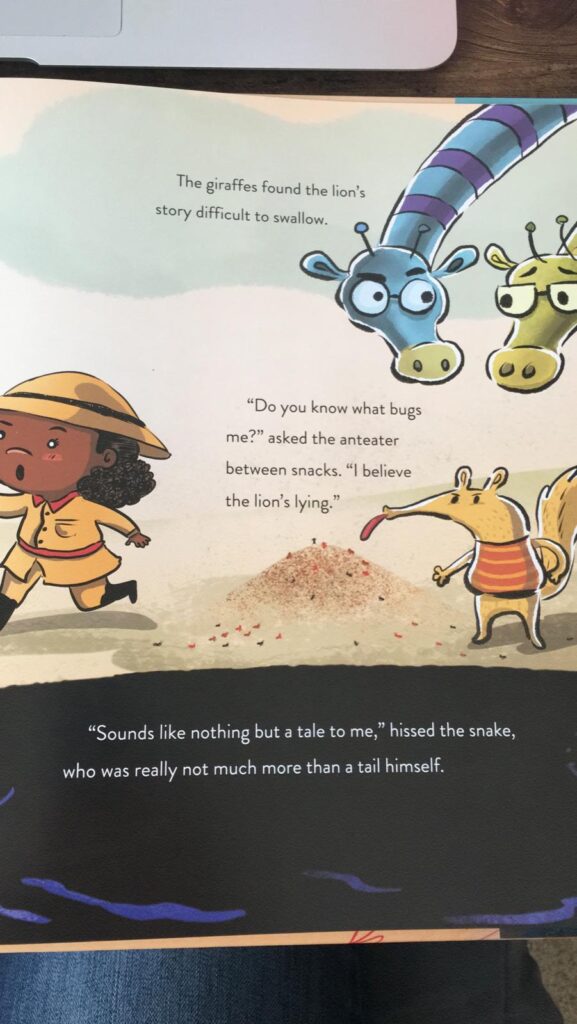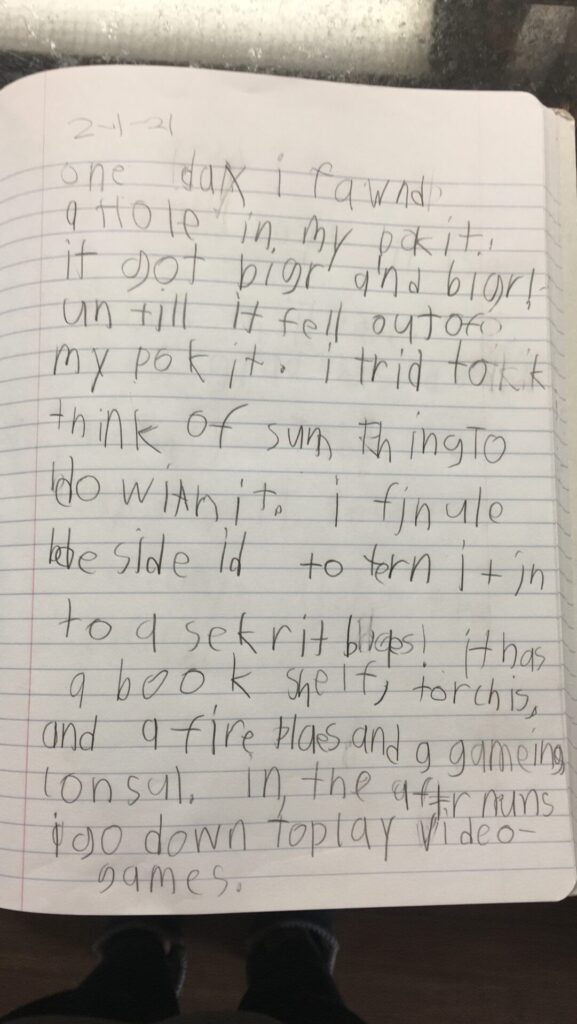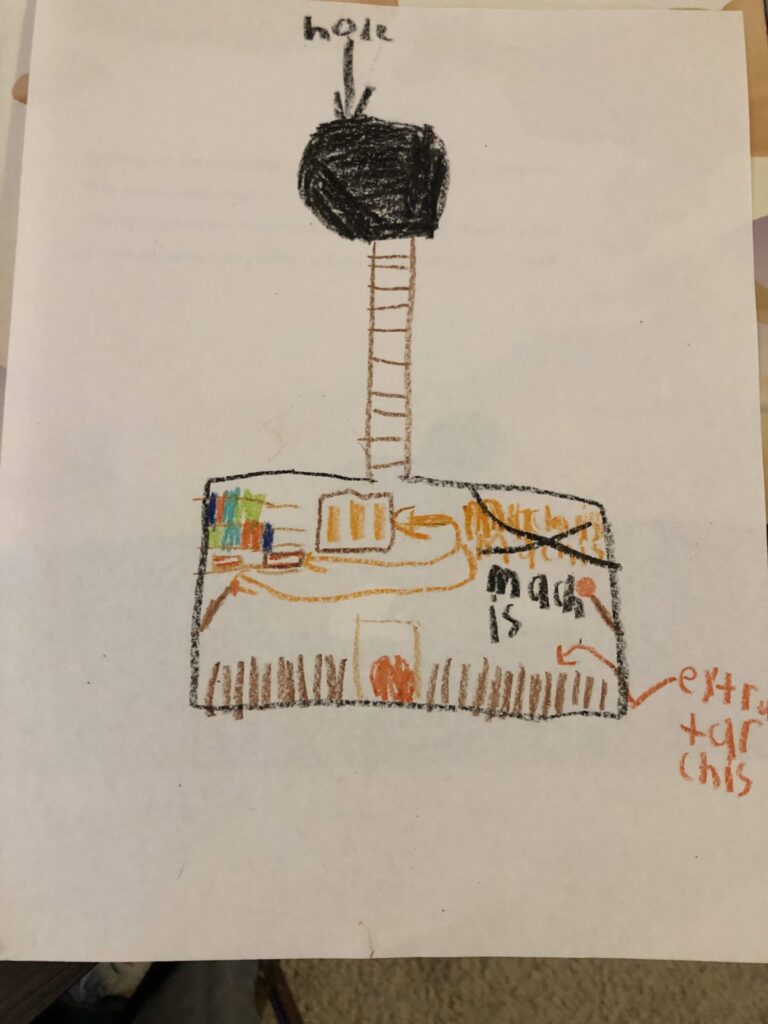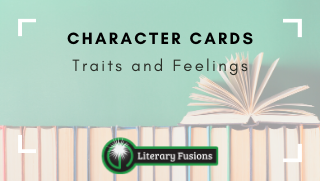
Why I Picked it Up: This book came in the mail! I love it when great books are brought to my attention and then show up in my mailbox! We were contacted by the illustrator, Ken Lamug, and asked if we would consider featuring The Whole Hole Story. To be honest, I probably would have picked this one up on my own – the play on words in the title, the colorful illustrations – it’s clearly an imaginative book and that is right up my alley!
Why I Finished It: I finished it because I couldn’t wait to see what would happen next! The Whole Hole Story is indeed an incredible adventure into Zia’s vivid imagination, which creates a world where anything can happen – and it does!
When the hole in her pocket starts to grow bigger, Zia falls into it (reminiscent of falling down the rabbit hole!) and begins to play. She blends the familiar with the fantastic – a regular ol’ fishing hole produces a “fat fish with bulgy eyes and fancy fins”, a swimming hole turns into a watering hole in full safari-mode – as she travels through her adventures!
One of the things I loved about this book was the way the adventures flowed seamlessly into one another, all centering around the main object – the hole. How many things can you do with a hole? Turns out – a lot! If this were a chapter book, every few pages would be a new chapter as Zia does something new with the hole, but the progression from one adventure to the next is so natural that you don’t question how, on one page you’re making mud pies at the bottom of a deep hole, and a few pages later, you’re riding an elephant in India. Living with a 7-year-old with a vivid imagination of his own, this kind of progression happens on a daily, sometimes hourly basis, but it’s a great reminder of the limitless possibilities of a child’s imagination.
As much as I loved the wordplay (which continues throughout the book!) and the story, the illustrations are the cherry on top. Lamug uses bright colors to create whimsical creatures and a landscape that has a certain dream-like quality to it on which Zia’s adventures take place. There is a distinct sense of action conveyed through the illustrations as well – Zia is in constant motion – which carries the reader so swiftly through the story that I found myself taking a deep breath at the end, much like anyone who lives with or teaches small children might do at the end of a day.
Who I’d Give it To: The Whole Hole Story belongs in any elementary classroom or in the home library of any elementary age kiddo. Middle school teachers will also find it a fun addition to their list of mentor texts (see ideas below)!
Integration Ideas
Text-to-Text Connections
This story reminded me of a kid with a cardboard refrigerator box – it’s not just a box, it’s a race car, it’s a lava pod, it’s an igloo…There are several books with this creative outlook on ordinary things that came to mind when reading The Whole Hole Story:
- Not a Stick and Not a Box, by Antoinette Portis
- Harold and the Purple Crayon, by Crockett Johnson
- What to Do With a Box, by Jane Yolen
- Alice’s Adventures in Wonderland, by Lewis Carroll
Theme
Optimism. A big, black hole can go both ways – it can be overwhelming and incredibly scary, or it can be an adventure. The way you see it depends on your attitude, and Zia’s outlook is definitely optimistic. Though she has a slight moment of terror after she first falls into the hole (wonderfully captured in her expression), Zia makes up her mind that she will have a great time in her adventure. She realizes that it’s her story, after all, so she makes the best of it.
Determination. This theme could easily be combined with optimism because it could be argued that one fuels the other. Armed with her positive outlook, Zia takes charge of the challenging situations in which she finds herself (tired of bickering animals, stuck at the bottom of a muddy hole, trying to pull an elephant out of hole) and imaginatively overcomes them. I love the reality in the story though, because in one instance, it takes two (w)hole pages of being stuck for her to get out (I think this is my favorite page!). Sometimes, we do have to wallow a bit and consider our options before we can continue, but nevertheless, Zia climbs out and resumes her adventure.



Character Traits and Feelings
Zia’s character experiences a whole range of emotions in this story, and the illustrations capture each so clearly!
Pick a few of Zia’s expressions (see images above for examples) and have students think about what she’s feeling. What would name might we give that emotion? You might have to provide a thesaurus here to help move students away from commonly-used feeling words – happy, sad, mad, even excited. Explore the nuances of those feelings and help students build their character vocabulary!
Then, have students start to create personal connections. Why is she feeling that way? Have you ever felt that way? What made you feel that way? What did you do about it?
Talk about the differences between traits and feelings. Traits are tried and true – they won’t change and they describe the true nature of a character. Feelings are fleeting – they can change with circumstances. What are some of Zia’s character traits?
Practice the difference between traits and feelings, or expand your students’ vocabulary with our new Character Cards!
Word Play
I loved the playful, yet matter-of-fact, tone of McInerny’s text throughout the story, but I particularly loved the puns and allusions sprinkled throughout the book.
Animals puns are the best – and there’s a whole page of them!

Have students think of other animal idioms and puns! Bonus points if they draw it!
Literacy and Creativity
This is the obvious connection, but it’s so powerful! In a world of plugged-in kids, imagination is becoming a lost skill. Let kids exercise it! Let them create their own stories that are not subject to rules or laws of nature. Let them dream up playmates or partners in crime that will accompany them on their story, if even just for a scene. Let them solve the problems they create with magic or with the shovel they pull out of their backpack.
As a teacher and a parent, I can see how Zia’s adventures might be inspired by her every-day activities – playing with stuffed animals, playing in the mud, and digging holes.
After reading the book, ask students: What would you do with a hole? See where their imaginations take them!


Connect with the Author and Illustrator
One of the first steps to being able to write creatively is to read imaginative stories, like The Whole Hole Story. Ken Lamug, the illustrator, talks about being at the library and how walking through the stacks of books was like “unravelling the secrets of the universe.” He says it felt like “each book had a story to tell you that no one else knew.” That’s how our kids are! Each one has a story in their head that no one else can tell. We hope you use this book as a way to encourage them to let that story out!
Check out the virtual launch party to hear more about The Whole Hole Story from the author and illustrator themselves!







Leave a Reply